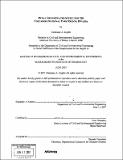Rural groundwater supply for the Volcanoes National Park region, Rwanda
Author(s)
Zoghbi, Christiane A. (Christiane Antoine)
DownloadFull printable version (28.91Mb)
Other Contributors
Massachusetts Institute of Technology. Dept. of Civil and Environmental Engineering.
Advisor
Peter Shanahan.
Terms of use
Metadata
Show full item recordAbstract
Water scarcity is a major issue faced by both developed and developing countries. According to the Millennium Development Goals set by the United Nations, the number of people that do not have access to an improved water supply should be halved by the year 2015. Rwanda is a Sub-Saharan developing country where water scarcity is an issue. This thesis presents results from a preliminary evaluation of possible groundwater supply to the village of Bisate, located in the Northern Province of Rwanda. Suffering from the "walk for water", the Bisate community has to give up vital activities such as school and agriculture in order to fetch water. During the dry season, the people are obliged to go into the Volcanoes National Park to get water from springs and swamps, disrupting the fragile ecosystem by the human activity. All these factors make it important to provide water at the point of use. Since the region receives a considerable amount of rain and the groundwater recharge rate is high (0.3 m/year), groundwater supply could be a feasible alternative for the Bisate community. For this thesis, three major tasks were achieved. (cont.) First, a description of the park's hydrogeology was developed based on previous studies and field observations. Second, a calculation of the groundwater recharge using the Water Balance Method was completed. And finally, a groundwater model was built using MODFLOW software. The aim of the model is to estimate the depth to the water table. The model results have shown that the water table could be as deep as 750 meters below the ground surface of quite shallow depending on the model assumptions. According to four trials, each with different boundary conditions and internal properties of the medium, the results were found to depend upon the assumed hydraulic conductivity and the boundary conditions. The strongest conclusion is that field investigations of the groundwater system are needed to determine actual aquifer properties and field conditions.
Description
Thesis (M. Eng.)--Massachusetts Institute of Technology, Dept. of Civil and Environmental Engineering, 2007. Includes bibliographical references (leaves 81-83).
Date issued
2007Department
Massachusetts Institute of Technology. Department of Civil and Environmental EngineeringPublisher
Massachusetts Institute of Technology
Keywords
Civil and Environmental Engineering.